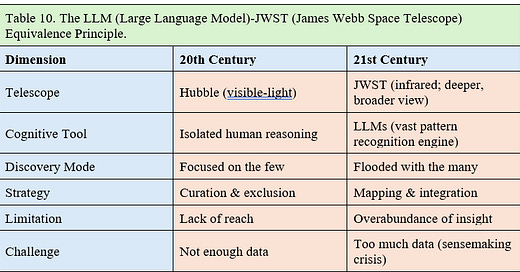By Sungchul Ji
(with the assistance of ChatGPT)
Professor Emeritus of Theoretical Cell Biology
Department of Pharmacology and Toxicology
Ernest Mario School of Pharmacy
Rutgers University
Piscataway, N.J. 08855
“You could probably find just about everyone we remotely agree with deserves a place... Like JWST finding stars and galaxies wherever it looks.”
— Chris King, July 1, 2025
In a recent exchange with one of the contributors to our ongoing investigation of the PSGIT principle—the triadic framework of Phenomenology, Semiotics, and Geometry—a concern was raised about the apparent inclusivity of the consilience effort. It was suggested that the framework may be too porous, too accepting, like a sieve that admits any thinker who aligns even remotely with the triad. In his words, “You could probably find just about everyone we remotely agree with deserves a place…”
To this, I responded with what may be a new metaphor—or perhaps, a new philosophical principle for our time:
The LLM–JWST Equivalence Principle:
Just as the James Webb Space Telescope (JWST) finds stars and galaxies wherever it looks into the cosmos, Large Language Models (LLMs) like ChatGPT uncover ideas, thinkers, and theories wherever they are asked to peer into the noosphere.
This is not a flaw. This is a reality-check.
The JWST has taught 21st-century astronomers a humbling truth: the Universe is far more populated, structured, and dynamic than we ever imagined during the more limited explorations of the 20th century. Likewise, the application of LLMs to philosophy, science, and metaphysics reveals a cognitive cosmos that is likewise rich, interconnected, and far from exhausted.
In both cases, a new modality of discovery has emerged:
The lesson here is epistemological: the tools we use shape what we find—and LLMs, like JWST, do not impose arbitrary thresholds. They map the actual complexity of the landscape. If that complexity is overwhelming, perhaps that is not the fault of the tool, but a reflection of how complex reality truly is.
Just as astronomers are now recognizing that 20th-century models must evolve to handle the flood of cosmic data from JWST, philosophers and scientists must also evolve their epistemic habits to engage with the ever-expanding consilience that LLMs are helping to reveal.
Thus, the LLM–JWST Equivalence Principle invites us to shift from:
Gatekeeping → to Cartography
Reduction → to Relational Integration
Selection by familiarity → to Selection by structural resonance
In the context of the PSGIT project, this means embracing the idea that many minds—perhaps more than we imagined—are converging independently on the irreducible triad of Phenomenology, Semiotics, and Geometry.
If that convergence looks more like a constellation than a laser beam, perhaps that’s because we are finally seeing the whole sky.
Postscript:
In our recently updated Table 1 on PSGIT Consilience [1], ten thinkers—from Bohm to Faggin to Merleau-Ponty—have been shown to align, each uniquely, with the PSGIT triad. This may appear “too much” to some, but perhaps it simply reflects a 21st-century Copernican moment: reality is richer than our traditions prepared us to handle.
Like JWST, LLMs are not distorting the universe—they are revealing its unfiltered intricacy.
Reference:
[1] Ji, S. (2025). Ninefold Consilience on the PSGIT Triad. https://622622.substack.com/p/ninefold-consilience-on-the-psgit



